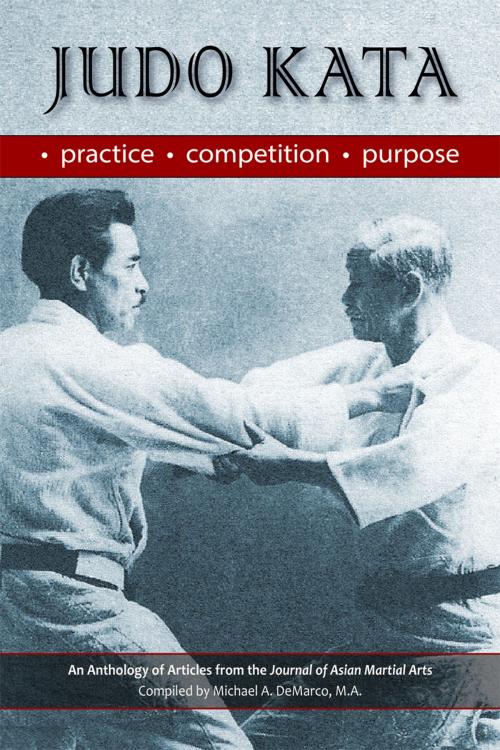| Author: | Llyr C. Jones, Ph.D, Biron Ebel, M.A., Lance Gatling, M.A., Michael Hanon, Ph.D., Linda Yiannakis, M.S., Martin P. Savage, B.Ed., Robert W. Smith, M.A. | ISBN: | 1230001366969 |
| Publisher: | Via Media Publishing | Publication: | September 30, 2016 |
| Imprint: | Language: | English |
| Author: | Llyr C. Jones, Ph.D, Biron Ebel, M.A., Lance Gatling, M.A., Michael Hanon, Ph.D., Linda Yiannakis, M.S., Martin P. Savage, B.Ed., Robert W. Smith, M.A. |
| ISBN: | 1230001366969 |
| Publisher: | Via Media Publishing |
| Publication: | September 30, 2016 |
| Imprint: | |
| Language: | English |
The practice of judo katas has changed over time as a result of perceived purpose. The chapters in this anthology were written by seven authorities in judo history and practice. Their writings clarify the purpose of kata and thus its mode of practice and their place in competition.
In 1926, a contest occurred in which thirty-seven of the finest judoka in Japan competed before the Emperor Hirohito. The first chapter by Robert W. Smith details the techniques utilized by each master and also compares their skills with today’s judo practitioners.
The next two chapters by Dr. Llyr Jones and Biron Ebell deal with the transmutation of judo over the decades. Both authors give ample support that the original guidelines have evolved into competitive sport resulting in a substantial decline in the number of adults practicing judo.
Where does kata stand in judo practice today? Dr. Lance Gatling reports on The First Kodokan Judo International Competition (2007). He outlines the background of the competition, the competitors, the motivations for this competition, the historical development of judo katas, and their importance to the correct study of judo.
Dr. Llyr Jones’ next chapter, with coauthor Dr. Michael Hanon has two objectives: to explain the purpose of kata in judo, and to critically evaluate the concept of kata championships. To achieve these objectives, Jones offers personal comments, observations from rare Japanese source material, as well as insight into the thinking of world-renowned judo experts.
Linda Yiannakis provides two insightful chapters. Her first chapter presents a conceptual framework for examining principles of judo throwing techniques. The principles are classified as primarily structural, operational, or contextual in nature. In her second chapter, she points out that martial artists are acutely aware of the need to develop a sense of timing for the best possible moment to apply techniques in free play or contest. This chapter examines some critical features of patterns and rhythms in a variety of contexts and provides a few basic exercises for the development of awareness and use of rhythm, patterns, and timing in judo.
Jones, Savage, and Gatling present an in-depth study into Kodokan Goshin-jutsu—a Kodokan judo exercise formally established in 1956 to teach the principles and techniques of self-defense against unarmed and armed attacks, and to meet modern lifestyle needs. Their chapter reviews the place of Goshin-jutsu among the Kodokan katas, and then summarizes the history its creation. A description of the exercise’s structure and technical contents follows, along with an in-depth explanation of its principles and associated teaching and learning challenges. This also includes a review of the most reliable learning texts in Japanese, English and selected other Western languages.
Kodokan Goshin-jutsu’s performance aspects are considered next. An objective assessment of its practical self-defense effectiveness follows, before finally conclusions are drawn.
The short final chapter by Dr. Jones is on Kodokan judo’s Nage-no-kata (forms of throwing) and Katame-no-kata (forms of control). Their study helps facilitate the development of free practice (randori) skills.
Many look at judo studies as including three dimensions: free-practice, competition, and forms. Kata practice is vital to the other two. If you are involved with judo, this anthology will deepen your purpose and inspiring your practice.
The practice of judo katas has changed over time as a result of perceived purpose. The chapters in this anthology were written by seven authorities in judo history and practice. Their writings clarify the purpose of kata and thus its mode of practice and their place in competition.
In 1926, a contest occurred in which thirty-seven of the finest judoka in Japan competed before the Emperor Hirohito. The first chapter by Robert W. Smith details the techniques utilized by each master and also compares their skills with today’s judo practitioners.
The next two chapters by Dr. Llyr Jones and Biron Ebell deal with the transmutation of judo over the decades. Both authors give ample support that the original guidelines have evolved into competitive sport resulting in a substantial decline in the number of adults practicing judo.
Where does kata stand in judo practice today? Dr. Lance Gatling reports on The First Kodokan Judo International Competition (2007). He outlines the background of the competition, the competitors, the motivations for this competition, the historical development of judo katas, and their importance to the correct study of judo.
Dr. Llyr Jones’ next chapter, with coauthor Dr. Michael Hanon has two objectives: to explain the purpose of kata in judo, and to critically evaluate the concept of kata championships. To achieve these objectives, Jones offers personal comments, observations from rare Japanese source material, as well as insight into the thinking of world-renowned judo experts.
Linda Yiannakis provides two insightful chapters. Her first chapter presents a conceptual framework for examining principles of judo throwing techniques. The principles are classified as primarily structural, operational, or contextual in nature. In her second chapter, she points out that martial artists are acutely aware of the need to develop a sense of timing for the best possible moment to apply techniques in free play or contest. This chapter examines some critical features of patterns and rhythms in a variety of contexts and provides a few basic exercises for the development of awareness and use of rhythm, patterns, and timing in judo.
Jones, Savage, and Gatling present an in-depth study into Kodokan Goshin-jutsu—a Kodokan judo exercise formally established in 1956 to teach the principles and techniques of self-defense against unarmed and armed attacks, and to meet modern lifestyle needs. Their chapter reviews the place of Goshin-jutsu among the Kodokan katas, and then summarizes the history its creation. A description of the exercise’s structure and technical contents follows, along with an in-depth explanation of its principles and associated teaching and learning challenges. This also includes a review of the most reliable learning texts in Japanese, English and selected other Western languages.
Kodokan Goshin-jutsu’s performance aspects are considered next. An objective assessment of its practical self-defense effectiveness follows, before finally conclusions are drawn.
The short final chapter by Dr. Jones is on Kodokan judo’s Nage-no-kata (forms of throwing) and Katame-no-kata (forms of control). Their study helps facilitate the development of free practice (randori) skills.
Many look at judo studies as including three dimensions: free-practice, competition, and forms. Kata practice is vital to the other two. If you are involved with judo, this anthology will deepen your purpose and inspiring your practice.















